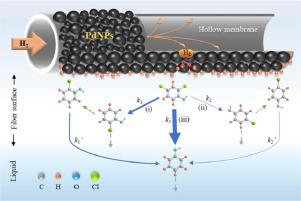Water Research ( IF 11.4 ) Pub Date : 2020-09-28 , DOI: 10.1016/j.watres.2020.116465 Chengyang Wu , Luman Zhou , Yun Zhou , Chen Zhou , Siqing Xia , Bruce E. Rittmann

|
We created a hydrogen-based membrane palladium-film reactor (MPfR) by depositing palladium nanoparticles (PdNPs) on hollow-fiber membranes via autocatalytic hydrogenation to form a Pd-film. The MPfR was used for hydrodechlorination (HDC) of 2,4-dichlorophenol (2,4-DCP). HDC performances and mechanisms were systematically evaluated, and a continuous-flow dechlorination model was established. Approximately 87% of the input 2,4-DCP was reduced to the end-product phenol (P), while 2-chlorophenol (2-CP) was an intermediate, but only at 2%. Selective adsorption of the 2,4-DCP onto the Pd-film and fast desorption of P facilitated efficient dechlorination. Modeling results represented well the concentrations of 2,4-DCP and its intermediates. It demonstrated three dechlorination pathways: The majority of 2,4-DCP was completely dechlorinated to P in an adsorbed state without release of monochlorphenol, some 2,4-DCP was degraded to 2-CP that was released and subsequently adsorbed and reduced to P, and a small amount was reduced to 4-CP that was released and subsequently adsorbed and reduced to P. Analysis based on Density Functional Theory suggests that the pathway of full dechlorination was dominant due to its thermodynamically favorable adsorption configuration, with both Cl atoms bonded to Pd. This study documents full dechlorination of 2,4-DCP in the MPfR and the interacting roles of adsorption and HDC.
中文翻译:

氢基膜钯-膜反应器中2,4-二氯苯酚的脱氯:性能,机理和模型开发
我们通过自动催化加氢将钯纳米颗粒(PdNPs)沉积在中空纤维膜上以形成Pd膜,从而创建了基于氢的膜钯膜反应器(MPfR)。MPfR用于2,4-二氯苯酚(2,4-DCP)的加氢脱氯(HDC)。系统评价了HDC的性能和机理,建立了连续流脱氯模型。大约87%的输入2,4-DCP还原为最终产物苯酚(P),而2-氯苯酚(2-CP)是中间体,但仅为2%。2,4-DCP在Pd膜上的选择性吸附和P的快速脱附促进了有效的脱氯。建模结果很好地代表了2,4-DCP及其中间体的浓度。它展示了三种脱氯途径:大多数2,4-DCP在吸附状态下完全脱氯成P,不释放一氯酚,一些2,4-DCP降解成2-CP,然后释放并吸附并还原成P,少量还原成4-CP根据密度泛函理论的分析表明,完全脱氯的途径占主导地位,这是由于其热力学上有利的吸附构型,两个Cl原子均与Pd结合。这项研究记录了MPfR中2,4-DCP的完全脱氯以及吸附和HDC的相互作用。基于密度泛函理论的分析表明,完全脱氯的途径占主导地位,这是由于其热力学上有利的吸附构型,两个Cl原子均与Pd键合。这项研究记录了MPfR中2,4-DCP的完全脱氯以及吸附和HDC的相互作用。基于密度泛函理论的分析表明,完全脱氯的途径占主导地位,这是由于其热力学上有利的吸附构型,两个Cl原子均与Pd键合。这项研究记录了MPfR中2,4-DCP的完全脱氯以及吸附和HDC的相互作用。


















































 京公网安备 11010802027423号
京公网安备 11010802027423号